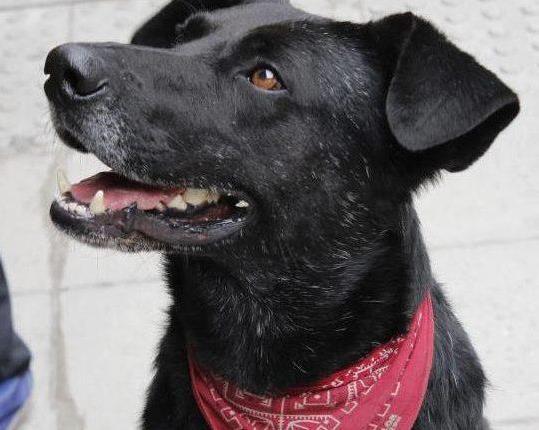
32 minute read
Lili Almási Szabó: Negro Matapacos | Street dog, hero or patron saint of protestors?
from antro-pólus 2020/3–4
by ELTE TáTK
Lili Almási Szabó
Negro Matapacos: street dog, hero or patron saint of protestors?
Advertisement
Abstract
Objective and context: The objective of this study is to analyze the dog-human relation in case of the Chilean mongrel dog, Negro Matapacos, known as hero to the society. The first Chilean riot dog is characterized by a heroic personality that has important supportive functionsin response to public precariousness. Without any physical barriers the dog transfers certain social values during and after his life. This article deals with different aspects of his heroic character and explores how he is seen by the protestors on political, social and personal levels. The experience of both life and death is key to the Andean mythology even in contemporary practices. The dog’s rich iconography in urban, political and personal spaces evidences the evolution of the dog-human relation. The animal becomes from street dog to patron saint of protestors. Methodology: There was no prefixed methodology in the framework of this study, but rather it was driven by personal experiences during the 2019-2020 protests and by theoretically relevant approaches. The dog’s iconography helps the reader to engage with anthropological interpretations as well as with aesthetics. Keywords: Negro Matapacos, animal heroes, human-dog relation, urban saints, protests
Introduction: Chilean protests now and back
Currently in 2019-2020 civil protests are being organized in the capital city, Santiago, and all over Chile in response to the increasing costs of living, inequality and privatization processes in the capitalist neoliberal system. A raise in Santiago Metro's subway fare triggered the evasion of some stations mid-October. The groups of protestors kept growing day by day, reaching a peak of over 1,2 million people in Baquedano square on
25th of November15. These facts give us the context of this study. However, in this article my aim is not to detail the cycle of protests and the sociopolitical crisis Chile is facing since 18th of October 2019 but to draw attention to one of the heroes of the protests and his relation to the protestors and others.
Black Cop-Killer, the hero among all street dogs
This hero became known from the years of 2011-2013 during students’ demonstrations in Santiago, asking for a better educational system. He is Negro Matapacos (in English: Black Cop-Killer), a black mongrel dog who gainedpopularity due to its participation in the protests on the side of students (Figure 1). His figure reappeared in the collective consciousness when 2019 protests started. Since then, the dog became an international icon of protest thus he “spreads the spirit of revolution” (Anania, 2019). Quickly arriving to remote lands with the help of social media, Negro Matapacos with his red bandana around the neck was used as a symbol to start riots in New York (see Figure 2). In many countries the image of the dog appeared to show solidarity towards the Chilean protests (see Figure 3). To mention two examples, in Japan, the statue of Hachiko16 dog was accessorized with a red bandana (Calderón, 2019), as well as the statue of Balto17 in Central Park, New York (Cooperativa.cl, 2019). Jaime Rodríguez (2013), sociologist from the University of Chile says that there are certain things that are happening on the streets, and are logical on the streets, they are validated only there. This black dog is one of those things. The dog reflects what it is to be on the streets. According to the sociologist, he also reflects a feeling of absolute precariousness. He is the dog of the streets. Not any kind of domestic dog, but a street dog in a vulnerable situation. The people on the streets are demonstrating against
15 President of Chile Sebastián Piñera announced a state of emergency on 18th of October after 81 metro stations were seriously damaged, 17 of them burnt. The ChileanArmy force was authorized to intervene in protests that use vandalism as a tool of expression. The riots have expanded over the major cities of the country and protests claimed 31 human lives as of 31st of January 2020 (Ulloa & CNN, 2020). The country claims that the recent cycle of protests is the "worst civil unrest" since the military dictatorship of Augusto Pinochet, considering the total worth of damage to public infrastructure and the number of actively participating protesters (Núñez, 2019). 16 Hachiko is a famous Japanese dog from Sibuja who became known because of his unique loyalty to his owner. He usually waited for his owner to get back from work at the railway station. After the man died when he was away, Hachiko kept waiting for him for over nine years in the same place. 17 Balto is the famous Siberian husky who transported diphtheria antitoxin from Anchorage, Alaska, to Nenana, Alaska in 1925, times of the deadly diphtheria epidemic.
precariousness of the citizens that occur parallel to the current governmental system. Symbols are very important here, because the character of the mobilization is determined through them (Rodríguez, 2013). A sense of unity can be revealed. There are thousands of photos of this dog on the internet. He appears with the bandana around his neck, surrounded by protestors, attacking policemen (see Figure 4 and 5). The “street dog”, which is below everything and everyone, disputes the power of “those above”. These are the small against the big powers. Humble people against the highest powers in hierarchy (Rodríguez, 2013). The black dog embodies the fight for a better future.
Placing the street dogs of Santiago and their relation to humans in context, we must understand that the city is home to around 250 thousand dogs (Schulz, 2010), in the rural areas of the country altogether the number of street dogs is estimated to 255 thousand (CNN, 2018). My experience confirms the high number of dogs wandering the streets. They walk in packs, obeying traffic lights, making no physical harm to humans. Santiago’s street dogs live in perfect harmony with humans in the city, sharing urban spaces. Street dogs form a part of the country’s urban culture thus we can understand why according to sociologist Jaime Rodríguez (2013) dogs can be reflections of people in the iconography of the protests.
Friend and faithful companion of a generation, even afterlife
A person -or in this case an animal -who shows the prototypicalhero features of bravery, sacrifice, conviction, risk-taking, and moral integrity for an honorable purpose is likely to provide psychological and social functions for individuals who encounter (or cogitate) about them (Kinsella, Ritchie, & Igou, 2015). Matapacos fulfills both psychological and social functions to people towards an honorable socio-political purpose: the state reforms. In what way does Matapacos provide psychological help to protestors? Other scholarly work indicates that persons use metaphors, myths, or symbols to give coherence to their lives (Campbell, 1988). Perhaps heroes, similar to powerful myths and metaphors, are used as tools for dealing with uncertainty (Van der Bos, 2009). Both leaders and heroes are described as offering guidance and leadership through the complexity of daily life. This is interesting given that many heroes do not occupy formal leadership positions (Kinsella, Ritchie, & Igou, 2015). A hero can become a leader in times of threat or unfulfilled needs, especially in situations when the individuals perceive social
isolation, uncertainty or simply low self-esteem (Kinsella, Ritchie, & Igou, 2015). The atmosphere of the neoliberal country was already characterized by unfulfilled needs and feelings of instability. Furthermore, the protests starting in October 2019 did provide the massive perception of uncertainty due to military intervention, wide-spread vandalism, ongoing governmental debates. As a reason, we may suspect that the figure of Negro Matapacos provided guidance to people, who felt that they were threatened by uncertainty on psychological, social levels. In my view, we can find the first pillar of the mentioned psychological help in the following qualities. We find proof to his fearlessness in a song honoring him says: “It is said he is the Cop-Killer that does not fear any rifle. That the police do not want to see him on the free protests to resist. It is said that in the fight he was an example and in the city they call him the companion of freedom” (see Annex 1 for full text and original language version) (Unknown Author, 2020). These lines introduce him as a fearless figure, even in a war-like situation facing police and rifles. An interviewed young protestor explains: “As I see, teargas and water does not do any harm to dogs. Black Matapacos always came with us since the very beginning of the riots'' (Ramirez, 2013). In these short sentences according to public opinion -we have found reference to his bravery and his risk-taking personality, and his overall capacity to face policemen. His restlessness to participate in protests was explained by Mrs. María Campos, the owner18 of Negro Matapacos in an interview:
“First I realized that he came home with a bandana in his neck. Somebody gave it to him. Second, he did not act like before, knocking the door gently, but he turned desperate to leave home. He became desperate when he knew there were riots outside, and he left flying to Alameda19. Once I was in the city center crossing a nearby street, and suddenly I saw him as he was leading a students’ protest towards Plaza de Armas.” (Ramirez, 2013) Here we understand that besides his bravery there is restlessness connected to the figure of the mongrel dog, that gives him a humanly aspect. He is usually “desperate” to go to the protests and he is witnessed “leading” the protests. His ability as a group leader is fueled by urge and excitement towards any protests. He is a canine leader unquestionably
18 Negro Matapacos was originally a street dog, but after meeting a few times with Mrs. María Campos on Paseo Ahumada he begun to visit her at home and finally settled there (Martinez, 2012). 19 The other name of Libertador Bernardo O’Higgins Avenue in Santiago, frequent home to protests.
accepted by a human group. According to Kinsella, Ritchie and Igou (2015) the qualities of bravery, leadership and strenuousness can be linked to the social functions that a hero accomplishes. The second pillar of the psychological support this dog provides to protestors may be found is the similarities between both parties. Cesar Millan, the internationally wellknown dog expert says “it becomes very obvious, by reading a dog, how stable or unstable his human companion is. Our dogs are our mirrors” (Millan, Be the Pack Leader: Use CESAR'S WAY to Transform Your Dog . . . and Your Life, 2008). In the Chilean case, we experience how street dogs can be perceived as reflections of their owners, the “people of the street” (meaning passers-by). Moreover, Cesar Millan (2008) argues that in a doghuman relation both parties can read each other’s emotions. As Rodríguez (2013) mentioned, there is a parallel understanding of precariousness that both people and dogs experience in today’s Chile. To build up the third pillar of psychological support, we should look at the immortality of Negro Matapacos. According to Kinsella, Ritchie and Igou (2015), heroes are often spatio-temporally distant (e.g., sometimes dead or remote). The black dog passed away from old age in August 2017, but his heroic figure is still fulfilling supportive function in 2019-2020 protests. If a hero creates a lasting impact it can achieve symbolic immortality. I would approach this question in an anthropological perspective in two dimensions. To the philosophical or spiritual dimension, immortality is understood as the continued existence of an immaterial soul or mind beyond the physical death of the body. As an example, the soul may be reborn. On a cultural or social dimension, the extension of life can refer to the continuous reproduction of the values represented by the hero, that continues even after life biologically terminates. In other words, there is a cultural heritage that is being passed on. To my understanding, the figure of Matapacos achieved symbolic immortality in both dimensions. Chilean protests are still being guided by him today, upon his values and his spiritual presence. Mrs. Campos continues telling us about the story of Matapacos. Among her words we may find proof of the dog's spiritual immortality.
“The day when there is a student protest outside, he knows about it. As if he was a reincarnation of someone else. It is very, very strange. You know, I have a traditionally catholic friend, she is the only one who talks to me about fears. She said, probably he is an evil creature, because he behaves unlike a dog. I am also a faithful Catholic believer.
But I know, he represents the youth. This dog cannot be any evil spirit. He wouldn’t let me bless him if he was.” (Ramirez, 2013) After saying this in the documentary of Ramírez (2013) we see her bending towards the dog and drawing three crosses with her fingers to his forehead while saying a prayer for his safe return, then kissing him (see Figure 6). As she says, she repeats this ritual every time before he goes to the protests. According to the well-known Chilean folklorist Oreste Plath (1955) the dog as an animal also achieves mysterious aspects in the Chilean popular imagination. In these forests of folklore, diabolic dogs, dog-men and the superstitions associated with howls or barks abound. Black dogs, for example, can be entities from a dark and parallel world, especially if they appear at night and surrounded by strange circumstances (Plath, 1955; Salazar, 2015). Knowing this, we can link this concept to the fears of Mrs. María’s friend who thought Cop-Killer might be a diabolic creature. Mrs. María mentions the black dog, Matapacos, might be the reincarnation of somebody20 due to his humanly behavior. “It is said that he is the reincarnation of a student previously passed away on protests” explains a forty-year-old taxi driver I have interviewed in December 2019. The reincarnated soul of a student in this dog is mentioned by secondary-school students as well in the documentary made by Ramirez (2013). A boy says: “It is said that he is a reincarnated student and that stuff.” The director asks: “So you all think he is the reincarnation of a dead student?” “Yes” – they all say unanimously nodding their heads and smiling (Ramirez, 2013). To the public opinion, the student passed away in protests among schoolmates, that would explain why the dog follows students to protests. The story matches the previous concept of immortality by Kinsella, Ritchie and Igou (2015), this time taking a religious interpretation of afterlife in a spiritual dimension. So, what happens after the death of the Chilean mongrel in 2017? On the second, cultural dimension we can observe the continuous reproduction of the values represented by the hero. Other dogs are taking similar heroic actions, also they are treated as heroes. They are fulfilling similar functions to Negro Matapacos. The first example is Pepe Matapacos(in English: Pepe the Cop-Killer) (Figure 7). He is described with a combative
20 We only know for sure that Matapacos first showed up in 2010, but we do not know his exact birth date. I have tried to make some research to find out who the reincarnated person might be. But for that, we would have to engage with the very process of reincarnation, which, to my view, would be a questionable topic to discuss in this article.
attitude towards police officers in protests of Concepción city. He especially dislikes the police water cannons and armored vehicles (MundoMascota, 2019). He was evidenced when trying to bite the waterjet in the air. He usually follows students to protest escaping from home, similarly to Negro Matapacos. His revolutionary attitude explains why Pepe is inheritor of the “surname” Matapacos. However, he suffered skin injuries and had visionary problems due to constant contact with toxic teargas (MundoMascota, 2019). The second example to Chilean canine heroes of the recent protests is Rucio Capucha21(in English: Hooded Blond) (Figure 8). He is one of the inheritors of the missions of legendary Negro Matapacos in Santiago city (MundoMascota, 2019). The dog was captured by photographers with a similar red bandana in his neck. Rucio Capucha is seen as a loyal friend of protestors even though, after getting injured on site, he was medically treated and later adopted (MundoMascota, 2019). The story of this unfortunate accident made volunteers organize the removal of street dogs from protests due to their expulsion to teargas and the high possibility of getting injured by police vehicles. The encounter with these canine heroes generates a social connectedness among protestors.
On the cultural dimension, the mentioned two dogs have similar personal characteristics to keep on fighting against governmental repression of protests. They symbolically inherited surnames as reference to the protestors and Negro Matapacos. On the other hand, the action of giving a name has a possessive aspect, at the same time it is a sign of closeness. Surnames can be understood as direction indicators of the life course of the individual (in this case, dog). The two dog’s mission is to continue what Negro Matapacos and his human followers have started. Surnames are given by humans to the dogs. To that point, citizens are the ones that bring Matapacos and his heritage to new life by naming them as inheritors. As there is unanimous acceptance of the two animals among the heroes of the protests22, we suspect a strong social connectedness behind.
21 The word capucha makes a reference to hoodies. Protestors often wear facial masks and/or hoodies to protect their nose and mouth from teargas. This is why protestsare sometimes referred to as encapuchados, in English, hooded. The word rucio,-a is a local variant to rubio, -a, meaning blond. The name of the dog Rucio Capucha translates as “Hooded Blond” or as “Blond with a hoodie”. 22 Besides canine heroes there are fantasy characters as well among the leaders of the protests. As an example, the group of the New Chilean Avengers 2019 is formed by Negro Matapacos; Pareman or Capitan Alameda (a man with face cover holding a stop-sign as armor); Spiderman (a man with a Spiderman costume); Nalcaman (a man dressed up from head to toe with leaves of the nalca plant); Pikachu (a woman with a Pikachu costume) (Arros, 2019). Theircharacters entertain massive protests in Santiago city.
Not only a hero, but a patron saint of protests?
We can consider the dog as a special bridge that connects and accompanies humans and non-humans both through life and in its passage to the world beyond23(Weinberg, 2019). In everyday contexts, dogs can mean company and at the same time protection to humans. Anthropologist Marina Weinberg (2019) discusses how this dog-human syntax is transformed when one of the companions leaves for the world of the dead. As she highlights, particularly in the Andean region "death is conceived as the beginning of a long transformation" where the identity of the dead "is built along the ritual action, which consists of the transformation, whose destiny is to be reborn in the other life " (Weinberg, 2019). Two years after his death, how did this canine-human relation transform between Negro Matapacos and his fellow protestors? I try to walk the reader through some examples of artworks honoring him, in order to understand this unique relation that the society maintains with the canine even after life. Criss Salazar (2019), independent chronicler and amateur urban history researcher writes about Negro Matapacos, the first Chilean riot dog. The mongrel already became a consolidated legend and "patron saint" of the protests. (Salazar, 2019). From this we can see that after the dog passed away, the society has placed him above, to a spiritual sphere. Altars around Santiago city are honoring the dog. The most important one was installed outside of the GAM (Centre Gabriela Mistral) in Santiago (Figure 9) where we see his lifelike statue surrounded by flowers, candles, graffiti paintings and posters of victims of the recent confrontations. Some street graffities also shows strong resemblance to altars. There are two that especially called my attention by the side of the GAM Center (Centro Cultural Gabriela Mistral) (Figure 10 and 11). These artworks show angelic figures placing a crown upon the headof Matapacos. He appears as an urban saint with a strongly meaningful symbolic setup around him. Other than on altars or wall-paintings, we see the saint-Matapacos’s icon on postcards, appearing with glory above the head (Figure 12). A similar icon was made for both Negro Matapacos and Rucio Capucha (Figure 13).
23Marina Weinberg (2019), social anthropologist from Argentina in her article Especies compañeras después de la vida: pensando relaciones humano-perro desde la región surandina tries to find answers to the questions: What does death do to human-dog relationships in the Andean world? In other words, how is this dog-human syntax transformed when one of the companions leavesfor the world of the dead?
Paper and metal sculptures of the dog can be found in Iquique and in Plaza Baquedano in Santiago. A paper-maché sculpture near Baquedano square (Plaza Salvador and Plaza de la Aviación) was of keyimportance in the first few months of 2019 protests (Figure 14). The biggest-ever-known Matapacos sculpture was carried by protesters on riots, memorial ceremonies were made around it, later was symbolically damaged by police forces. The sculpture was used in various functionalities, among them to create a sacred space to the memorial of victims. Smaller sculptures of the dog were captured by photographers in places damaged by the protesters (see Figure 15). In that place, the statue “invocates his presence” according to the photographer (Colina, 2019). Additional artworks,poems andsongs (Annex 1) were written, postcards, stickers, tarot card designs (Figure 16), magnets, wall-paintings (Figure 17) were made in his honor. Even a dance24 on a festival’s stage was dedicated to Negro Matapacos. A video game was developed by Nemoris Games in Unity in honor of the riot dog, in which the gamer must take the place of the icon of protests, Matapacos (Figure 18). The mission of the game is to prevent armed forces from approaching protesters (Matteucci, 2019). Cartoons were also published on Twitter (Figure 19) among other heroic pictures and memes about the dog (Figure 20). Personal items with his image, such as T-shirts, phone cases, earrings, nail designs, cigarette holders surely mean a personal closeness to the dog. Tattoos, to my view, are showing a deep dimension of this personal closeness (Figure 21). The revolution itself can mean a deep and unforgettable experience to any participants, but a tattoo image may mean that Matapacos is the essence of all that experience. With a tattoo, the owner decides to be accompanied by the dog for a whole life. The riot dog does not only have a political and social significance to people but there are personal and emotional attachments as well.
These artworks are all reminding us to the heroic figure of Negro Matapacos, at the same time these make him alive even after life. His inheritance is being transferred to the next generation; the socially recognized values are being passed on. In a sense, his representation on objects make protestors feel his presence on an everyday basis.
24 In the Festival of Olmué 2020 the folklore group 3x7 veintiuna danced the last cueca in the honor of Negro Matapacos. Announced by the singer of the band, Daniel Patricio Muñoz, both the song and the dance was celebrated by the audience (Henríquez Ordenes, 2020).
To make a deeper political analysis of the dog’s wide iconography, we may consider riot flyers and posters that use his image (Figure 22). Flyers and posters calling for assemblies all over the country memorialize the black dog. To mention another symbolically important object, bandanas are sold on streets to protestors, mainly in red color (Figure 23). Besides being commemorative, those tiny textiles also fulfill important functions: protesters can use them as face-covers against teargas and to prevent later facerecognition by cameras of authorities.
In summary: from street dog to patron saint
According to Cesar Millan, if you give your dog any opportunity for him to lead you, he will take it (Millan, 2007). Negro Matapacos, a humble street dog took the lead of a whole society. The youth knows Negro Matapacos as a faithful comrade who endured tear gas and water cannons, and who only ever attacked or barked at policemen (Anania, 2019). In a universal sense, individuals who die on the battlefield are usually recognized by the society as heroes. They are the ones that remind us of history and to the sacrifices the society made in thehope of a better future. They seem to defend the highest values of the community and fight against dangers. Even though Negro Matapacos did not die on the event of a protest, he did suffer there thus he became recognized by the Chilean and by the international society as a hero. Heroes show moral fortitude, protect against threats, help fight disillusionment, promote cultural values and norms, help to create meaningful life based on society’s values. May a patron saint do something similar? A patron saint would enable us to do what no one else will, to be heroes ourselves. Chilean youth is fighting for a better future and Negro Matapacos has a role in that fight. His virtues are to instill hope, to be a role model, to save, to inspire, to act against evil or danger, to motivate, to guide, to show morals and values, to remind people about good. His altars and wall-paintings are filled with meanings in the eyes of the society. They are filled with hope towards a better world, with equality and dignity to Chile.
Figures
Figure 1 – The most known portrait of Negro Matapacos. Source: (Chilevisión, 2019)
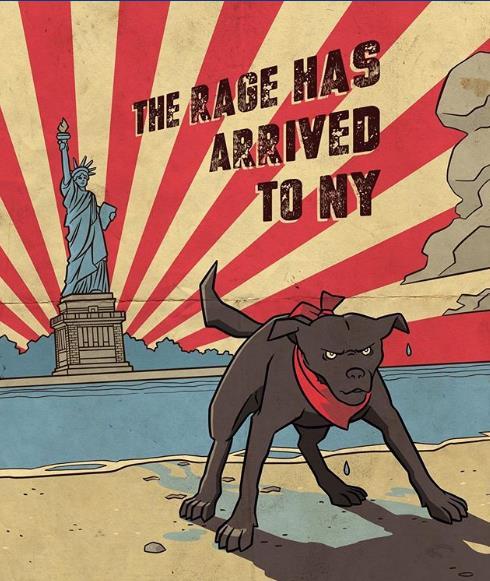
Figure 2 – Negro Marapacos’s figure is used in New York’s 2019 protests. Source: (Chilevisión, 2019)
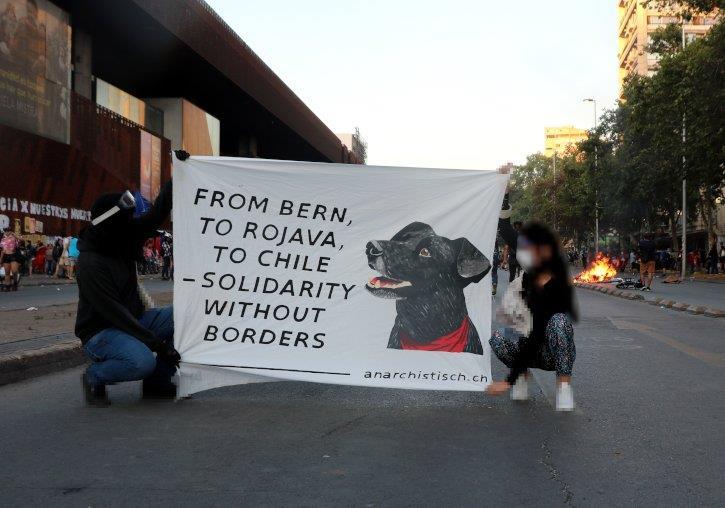


Figure 3 – Foreign protesters show solidarity with banners in Santiago (2019). Poster in Melbourne, Australia, to call for solidarity with Chile (2019). Below: home photo with black cat wearing red bandana to show solidarity with Chile, from Stamford, Connecticut (2019). Source: Twitter, 2019.
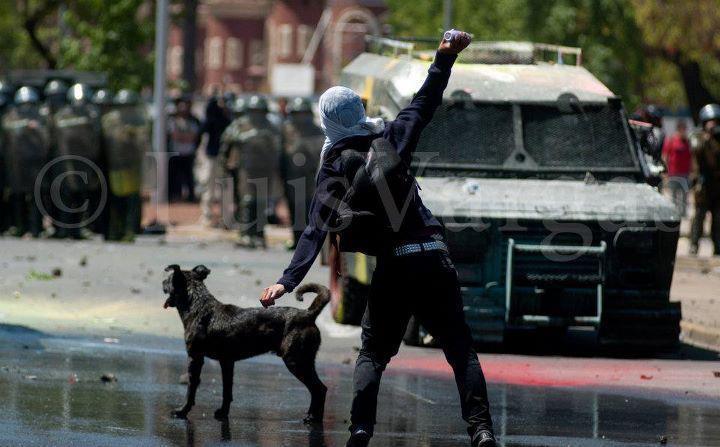
Figure 4 – Source: Henríquez Ordenes (2020).

Figure 5 – Negro Matapacos attacking policemen. Source: Henríquez Ordenes (2020).
Figure 6 – Mrs. María blessing the dog before he leaves home. Source: Documental Negro Matapacos (Ramirez, 2013).
Figure 7– Pepe Matapacos and his iconic photos from protests in Concepción, 2019. Source: Twitter (2019; 2020).
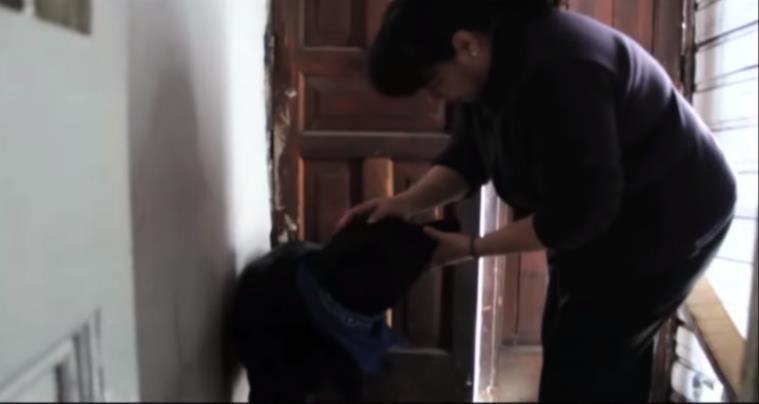
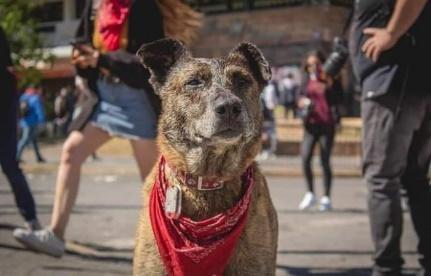
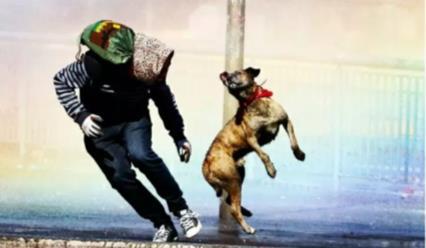
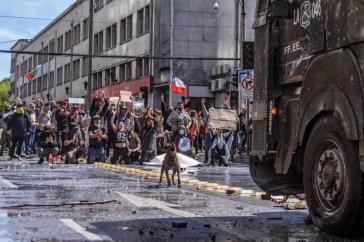
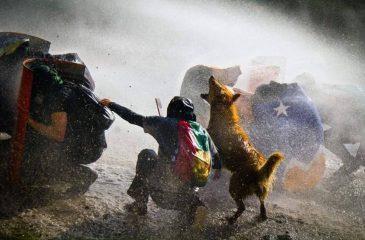
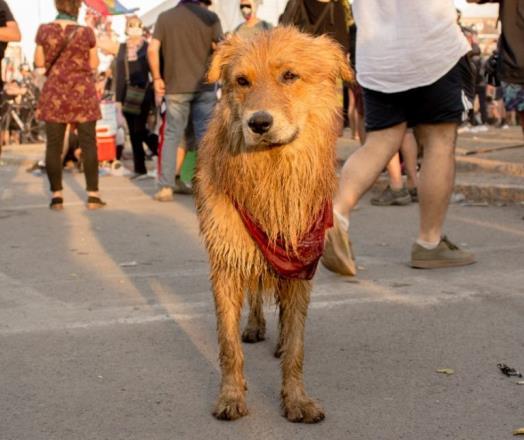

Figure 8 – Three iconic pictures of Rucio Capucha photographed at interventions of police using water cannons. Source: Instagram (2020), Twitter (2020).
Figure 9 – The altar created in the honor of Negro Matapacos was installed outside of the GAM (Centre Gabriela Mistral) in Santiago. Source: (Cooperativa.cl, 2019)

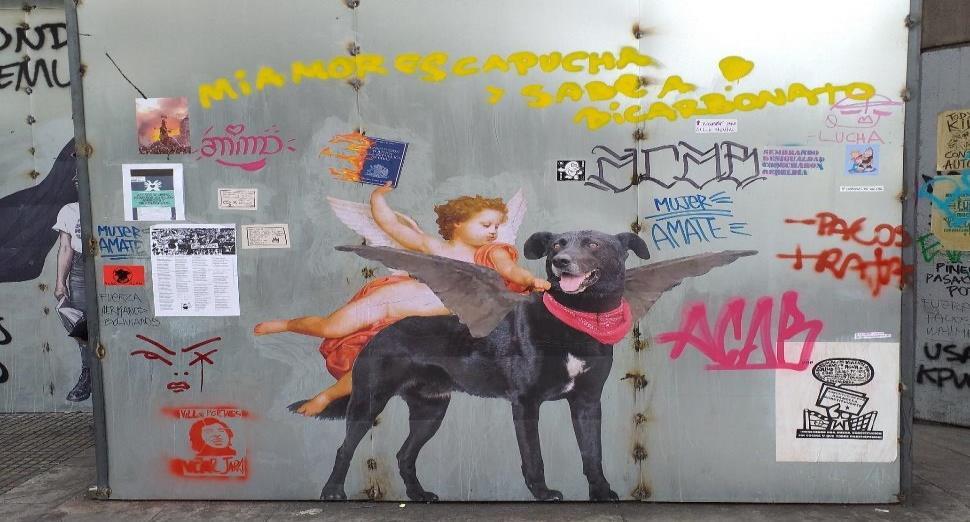
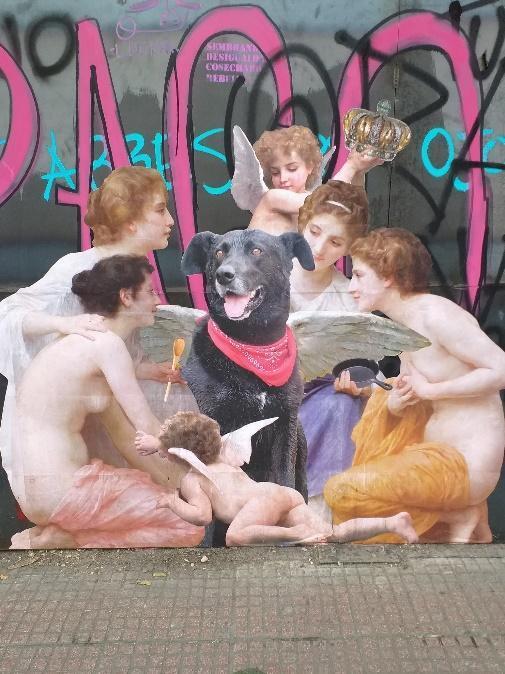
Figure 10 – Artwork on the outer walls of GAM. An angel holding the burning constitution of Chile is riding on the back of the Black Cop-killer. Both appear as angels, wearing wings. The artwork is surrounded by stickers, posters and graffiti with diverse massages of protestors. Source: own photo (2019).
Figure 11 – Artwork on the outer walls of GAM. We see women protesters and an angel placing a crown on Cop-Killer’s head. He appears as an angelic figure with wings. In the hands of the angel-like protester we see a frying pan and a wooden spoon, typically used on the Chilean protests to make noise. Source: own photo (2019).
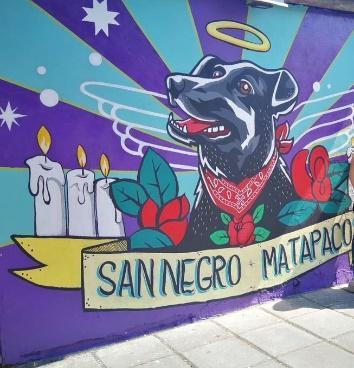


Figure 12 – Iconography of Negro Matapacos as an urban saint. Source: Instagram (2020), Twitter (2020).
Figure 13 – Postcard designs of Negro Matapacos and Rucio Capucha, appearing as patron saints. Source: Instagram (2020), Twitter (2020)

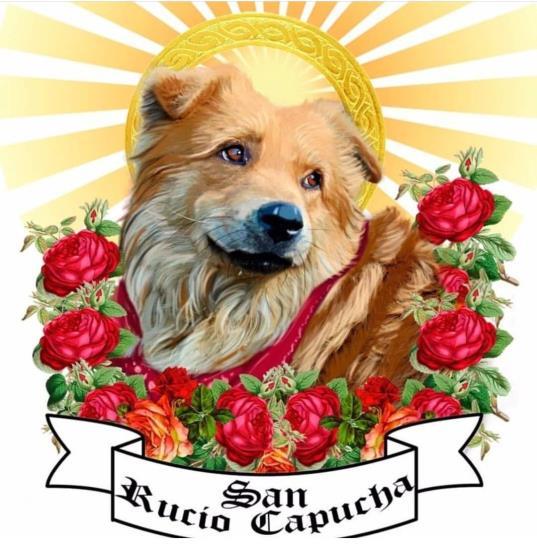
Figure 14 – Pedestrians taking photos on Plaza de la Aviación with the giant paper-maché sculpture of Negro Matapacos and Mapuche flag. Source: Radio ADN (2019).

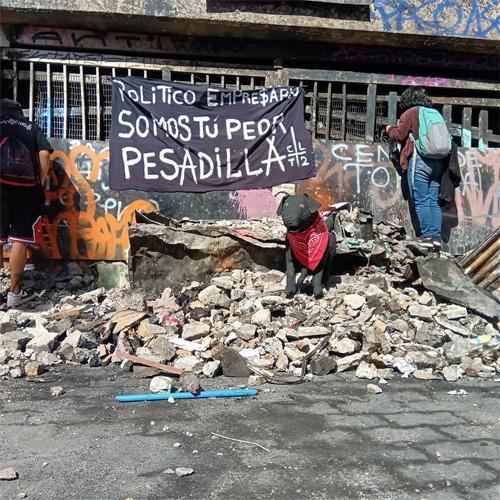
Figure 15 – Matapacos sculpture used in demonstration sites, almost as an "invocation". Image source: Urbatorium website of Chilean urban legends. Photographer: Enrique Colina, who walks and photographs the figure of the dog made of paper-maché in different locations. Source: Urbatorium (2019), Salazar (2019).

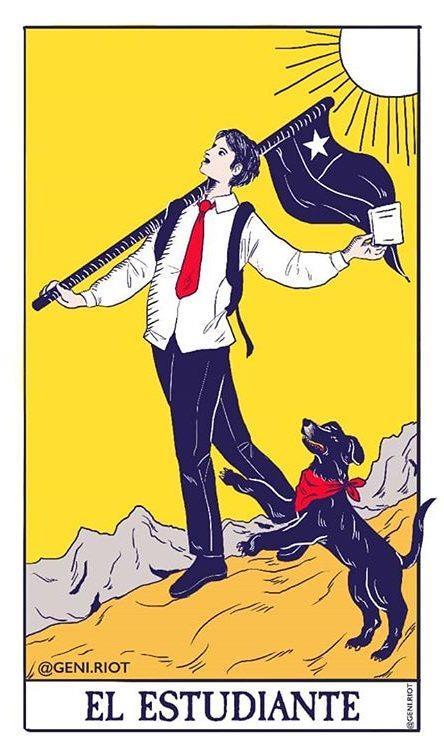

Figure 16 – Tarot card designs: Left, labelled as “the brave” showing Matapacos holding the Chilean flag, surrounded by teargas used by the local police; center, labelled as “the student”; right, labelled as “the force”. Sources: Berant (2019), matapacos.cl (2020).
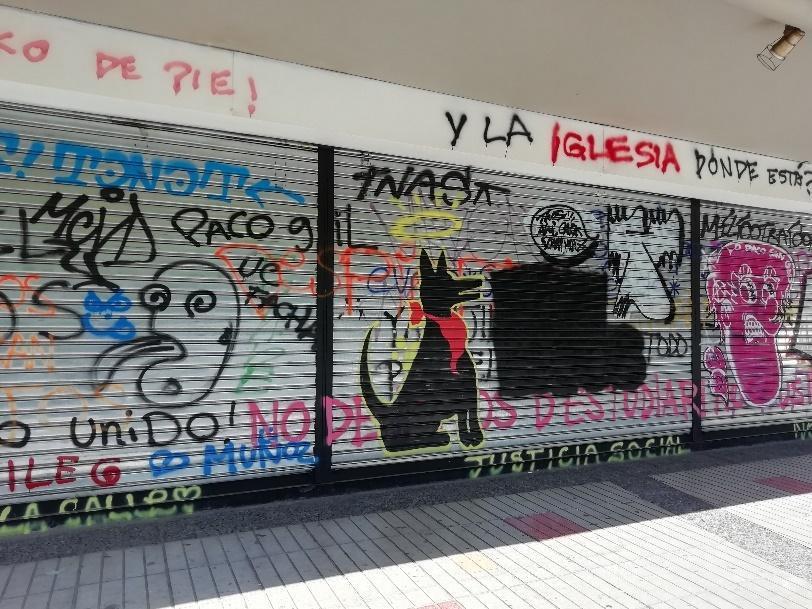
Figure 17 – Wall-painting at Plaza Nunoa, Santiago. Source: own photo, January, 2020.

Figure 18 – Protests’ scenery from videogame. Source: (Matteucci, 2019)

Figure 19 – Cartoon distributed online by MalaTienda on Twitter (MalaTienda, 2019). Source: Twitter, MalaTienda (2019).
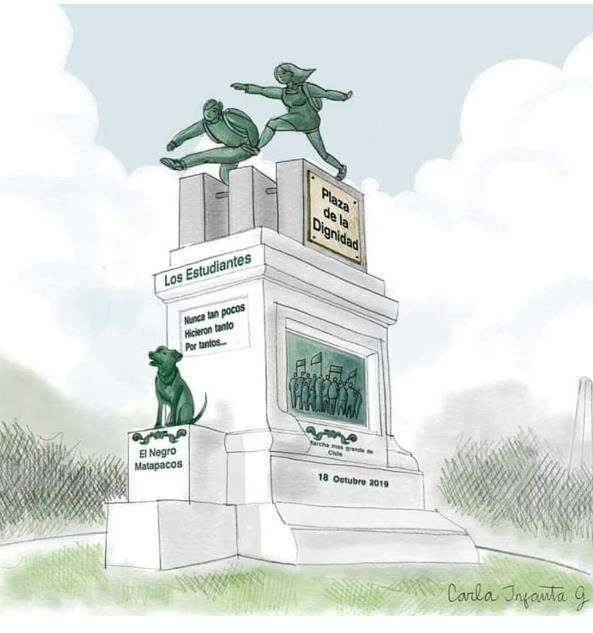
Figure 20 – Drawing of a fantasy design of Baquedano Square’s main statue that depicts the heroes of the revolution 2019-2020. On the front we see Negro Matapacos; on the side the protestors’ mass dated to 18th October 2019; on the top very first students who jumped over the entry of the metro station to show their anger after the rise of the metro pass prices. Originally in the square we see a monument to General Baquedano, however during the 2019-2020 protests this public space was home to massive manifestation. Source: Twitter, drawing made by Carla Infanta (2019).

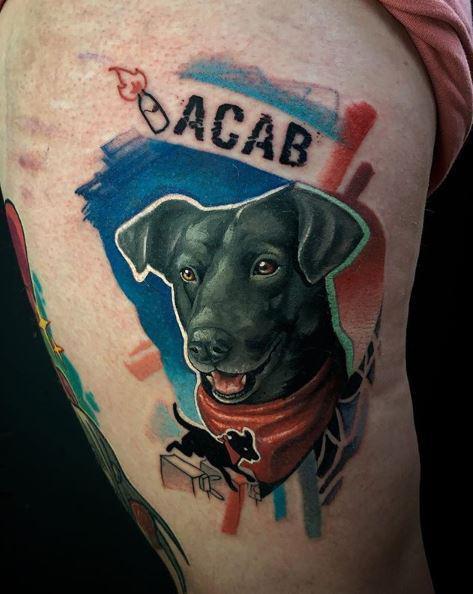
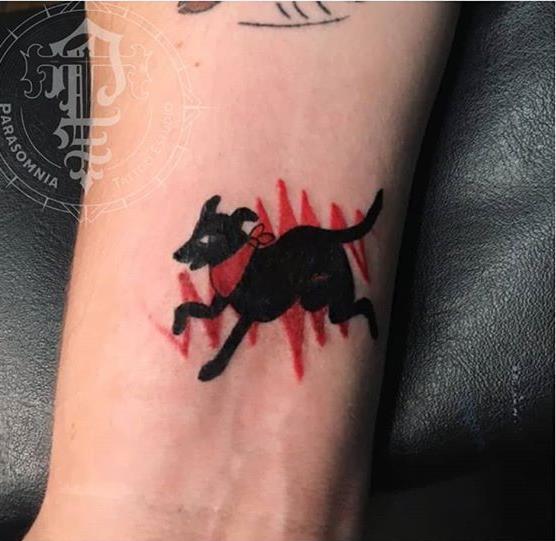
Figure 21 – Tattoos made in honor of Negro Matapacos. Source: Twitter (2019).

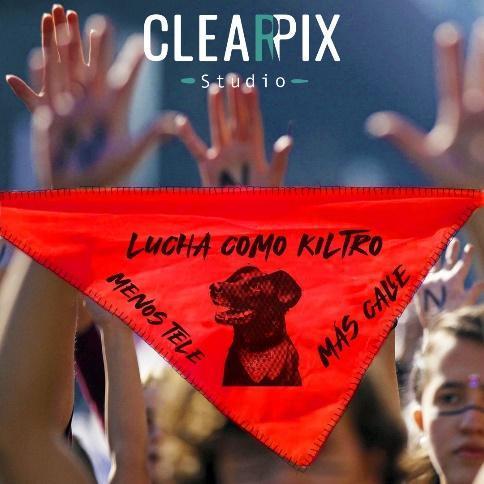
Figure 22 – Call for 22nd November protest, 2019. “The revolution is already here, there is no way back”. Beside the illustration of Jorge González, we see a flag with Matapacos’s figure and a papier-maché sculpture of the dog. Source: Twitter (2020).
Figure 23 -Red bandana often sold by street vendors in Santiago during and after protests. The message says: “Fight as a mongrel, less TV, more street”. Source: Clearpix Studio Webshop (2020)
Annexes
Song to honor Matapacos
Spanish version (original)
Por unos colmillos blancos que entre tanto humo viera relucir, y esa rabia que escondía no sé qué secretos y era para tí. Cuando viejo se marchó de este mundo tan hostil, me nubló un presentimiento al verlo partir. Dicen que es el Matapacos que no le teme a ningún fusil, que la yuta no le quiere ver por las protestas libre al resistir. Dicen que en la lucha fue ejemplo y en la ciudad lo llaman el companero de la libertad. Solo sé que ausente va que aúlla desde las estrellas, que amarrado nunca estuvo declaraba su rebeldía. Solo sé que al viento va jugueteando entre sus pelos, que el fuego brilla en sus ojos cuando el gobierno comienza a reprimir. Dicen que era como un rayo cuando el Negro los corría hacia el cartel, junto a sus amigos quiltros25 que nos acompanarán hasta vencer. Yo no sé si volveré a verle libre y gentil. Solo sé que sonreía por el porvenir. Solo sé que sonreía por el porvenir.
English version (own translation):
For some white fangs thatamongst so much smoke I saw shine, and that rage, he hid I don't know what secrets were for you. When at old age he left this world so hostile, it clouded my feeling as I saw him leave. It is said he is the Cop-killer that does not fear any rifle. That the police do not want to see him on the free protests to resist. They say that in the
25 Quiltro is an expression used for dogs, particularly for mongrel dogs in Bolivia and Chile (Real Academia Espanola, 2020).
fight he was an example and in the city they call him the companion of freedom. I only know that he is absent, that he howls from the stars, that he was never moored declaring his rebellion. I only know that the wind plays in his fur, that the fire shines in his eyes when the government begins to repress. They say it was like a lightning when the Black chased them back to the station
along with his mongrel friends who will accompany us until the end.
I don't know if I will see him free and gentle again. I only know that he was smiling for the future. I only know that he was smiling for the future. Source: Unknown Author (2020)
References
Anania, B. (2019. november 5). The Cop-Attacking Chilean Dog Who Became a Worldwide Symbol of Protest. Hyperallergic. https://hyperallergic.com/526687/negro-matapacos-chilean-protest-dog/ Armand, B. (2017. agosto 27). Murió el legendario “Negro Matapacos”. LaIzquierdaDiario. http://www.laizquierdadiario.cl/Murio-el-legendario-Negro-Matapacos Arros, F. (2019. noviembre 6). “Avengers chilenos”: Las figuras de las manifestaciones agrupadas por Twitter. Mouse, old.: 1. http://mouse.latercera.com/avengers-chilenos-twitter-manifestaciones/ Berant, M. (2019. octubre 24). El valiente. Instagram. Chile. https://www.instagram.com/p/B4BUaQJjSUK/ Calderón, M. (2019. noviembre 14). Nacen más homenajes al Negro Matapacos, incluyendo un altar y hasta la estatua de Hachiko en Japón. FayerWayer. Chile. https://www.fayerwayer.com/2019/11/hachiko-negro-matapacos/ Campbell, J. (1988). The Power of Myth. New York: Doubleday. Chilevisión. (2019. noviembre 5). Quién era el “Negro Matapacos”, el perro símbolo de la protesta social en Chile. CHVnoticias. Chile. https://www.chvnoticias.cl/trending/negro-matapacos-simbolo-protesta-socialchile_20191105/ Clearpix. (2020. marzo 5). Pañuelo lucha como kiltro. Clearpix Studio. https://clearpix.cl/producto/panuelo-lucha-como-kiltro/ CNN, C. (2018. noviembre 14). Más de 343 mil perros y gatos sin dueño circulan por las calles y zonas rurales de Chile. Chile. https://www.cnnchile.com/pais/mas-de-343-mil-perros-y-gatos-sin-dueno-seregistran-en-chile_20181114/ Colina, E. (2019. noviembre 2). Matapacos: La leyenda del primer riot dog chileno. Forrás: Urbatorium: https://urbatorium.blogspot.com/2019/11/matapacos-la-leyenda-delprimer-riot.html Cooperativa.cl. (2019. noviembre 14). Crean altar en homenaje al "Negro Matapacos". Cooperativa.cl.
https://www.cooperativa.cl/noticias/pais/manifestaciones/crean-altar-en-homenajeal-negro-matapacos/2019-11-14/062412.html#gal_id&slide=foto_5 Cooperativa.cl. (2019. noviembre 19). También en EEUU: El homenaje al "Negro Matapacos" en la estatua de Balto de Central Park. cooperativa.cl, old.: 1. https://www.cooperativa.cl/noticias/pais/manifestaciones/tambien-en-eeuu-elhomenaje-al-negro-matapacos-en-la-estatua-de-balto/2019-11-19/140116.html Gutiérrez, C. (2019. diciembre 20). Protestas en Chile: Negro Matapacos y otros superhéroes que persisten en la cultura pop. ElComercio. https://elcomercio.pe/luces/arte/protestas-en-chile-negro-matapacos-y-otrossuperheroes-que-persisten-en-la-cultura-pop-noticia/ Henríquez Ordenes, F. (2020. enero 20). Daniel Muñoz homenajeó al "Negro Matapacos" con las cuecas de 3×7 en Olmué 2020. El Universal.
https://eluniversal.cl/contenido/9058/presentacion-completa-daniel-munozhomenajeo-al-negro-matapacos-con-las-cuecas-d Henríquez Ordenes, F. (2020. enero 20). Revista de arte de EEUU destaca al “Negro Matapacos” como un símbolo mundial de protesta. ElUniversal, Chile. https://eluniversal.cl/contenido/9057/revista-de-arte-de-eeuu-destaca-al-negromatapacos-como-un-simbolo-mundial-de-pr Kinsella, E., Ritchie, T., & Igou, E. (2015). Lay perspectives on the social and psychological functions of heroe. Frontiers in Psychology, 3-10. MalaTienda. (2019. noviembre 9). Twitter. https://twitter.com/MalaTienda/status/1193204074713374721?ref_src=twsrc%5Etfw %7Ctwcamp%5Etweetembed%7Ctwterm%5E1193204074713374721&ref_url=https% 3A%2F%2Felcomercio.pe%2Fluces%2Farte%2Fprotestas-en-chile-negro-matapacos-yotros-superheroes-que-persisten-en Martinez, C. (2012. noviembre 6). La otra vida del negro matapacos. TheClinic. https://www.theclinic.cl/2012/11/06/la-otra-vida-del-negro-matapacos/ matapacos.cl. (2020. marzo 5). Negro Matapacos por un Chile más justo. https://matapacos.cl/ Matteucci, C. (2019. november 16). Negro Matapacos: Estudio chileno desarrolla videojuego en honor al querido perro. Tarreo. https://www.tarreo.com/noticias/550814/Negro-Matapacos-Estudio-chilenodesarrolla-videojuego-en-honor-al-querido-perro
Millan, C. (2007). Cesar's Way: The Natural, Everyday Guide to Understanding & Correcting Common Dog Problems. USA: Three Rivers Press. Millan, C. (2008. September 23). Be the Pack Leader: Use CESAR'S WAY to Transform Your Dog . . . and Your Life. United States of America: New York Times. MundoMascota. (2019. noviembre 17). Pepe Matapacos, perro luchador de Concepción, Chile. Mundo Mascota. Chile.
https://www.youtube.com/watch?v=FqXs_akzuAY&list=PLwOJmO2RSGDYwWZ532bTS fwNtrBEFln3r&index=4&t=0s
MundoMascota. (2019. noviembre 27). Rucio Capucha: El perro manifestante en Chile. Mundo Mascota. Chile.
https://www.youtube.com/watch?v=jnizpzB_aSk&list=PLwOJmO2RSGDYwWZ532bTSf wNtrBEFln3r&index=6&t=0s
Núñez, M. (2019. noviembre 20). Cronología del estallido social chileno. Tele13, Chile. https://www.t13.cl/noticia/nacional/interactivo-cronologia-del-mayor-movimientosocial-chile
Plath, O. (1955). El perro y el pueblo chileno. En Viaje. Radio ADN. (2019. noviembre 15). Estatua del perro "Negro Matapacos" llamó la atención de transeúntes de la Plaza de la Aviación. Fotogalería. Chile, Región Metropolitana. https://twitter.com/adnradiochile/status/1195464876468187137 Ramirez, V. (Rendező). (2013). Documental Matapaco [Film]. Chile. https://www.youtube.com/watch?time_continue=23&v=wiEFhAAWCiw&feature=emb_l
ogo Real Academia Espanola. (2020. February 2). Diccionario de la lengua española. RAE. https://dle.rae.es/ Rodriguez, J. (2013). Los perros de la calle. Documental Matapaco. (V. Ramírez, Kérdező:) Universidad de Chile, Santiago de Chile: Enmarcha Films. Salazar, C. (2015. marzo 9). Huellas de perros por el cemento fresco de Chile (parte II): El lado más perruno del criollismo, la cultura popular y la construcción de la identidad. Urbatorium: https://urbatorium.blogspot.com/2015/03/huellas-de-perros-por-elcemento-fresco_9.html Salazar, C. (2019. noviembre 2). Urbatorium. Forrás: Matapacos: la leyenda del priemr riot dog chileno:
https://urbatorium.blogspot.com/2019/11/matapacos-la-leyenda-del-primer-riot.html Schulz, V. (Producer). (2010). Lost dogs of Chile [Film]. Soto Parraguez, A. (2013). Análisis de un problema público no abordado el caso de los perros vagabundos y callejeros en Chile. Santiago, Chile. http://repositorio.uchile.cl/handle/2250/113119 Ulloa, C., & CNN. (2020. Febrero 5). 31 muertos en Chile desde que comenzaron las protestas en octubre de 2019. Chile. Unknown Author. (2020. febrero 8). En memoria del Negro Matapacos. JezTV, Chile. https://www.youtube.com/watch?v=kgqotCSWnbg Van der Bos, K. (2009). Making sense of life: the existencial self trying to deal with personal uncertainty. Psychol. Inquiry 20, 197-217. Weinberg, M. (2019. julio-septiembre). Especies compañeras después de la vida: pensando relaciones humano-perro desde la región surandina. Antipod. Rev. Antropol. Arqueol. n.o 26, old.: 139-161.




